FTW Project Concepts
Here are descriptions of the current project concepts:
- Find your people on campus
- Exercise Tamagotchi
- Local Fashion Exchange
- Lean Mean Pet Feeding Machine
- Invasive Species Finder
- FreeWork: Digital Work from Everywhere
- NutriSnap
- Localizing the College Student Palette
- Dish Data
- Pocket Dad
Here are pending projects, which are close but not yet acceptable:
Find “your people” on campus
Problem:
- New students to a campus can feel isolated and alone. It can be hard to find others to form friendships with based upon common interests and activities. In some cases, this can lead to the belief that college is “not for you” and dropping out after a semester.
Solution:
- This app will allow students to post what classes they are taking, other campus activities they are part of, and what their interests are. Students can also search and explore for classes (to see who’s taking a specific class), or search for a student (to see what classes/groups they are in and what their interests are).
- Special care will be taken in the design of this app to interview underrepresented and at-risk students to determine what features would help them find community and support in a campus setting.
- Ultimately, we hope that this system will increase retention rates among under-represented groups who often leave the university without obtaining their degree. This will result in a more diverse campus community, improving the university experience for everyone.
Why mobile:
- Most social media is mobile, and it is more convenient to access on the go and in between classes. People are also used to contacting others via their phones, since it is a more casual medium.
Lean Canvas business model:
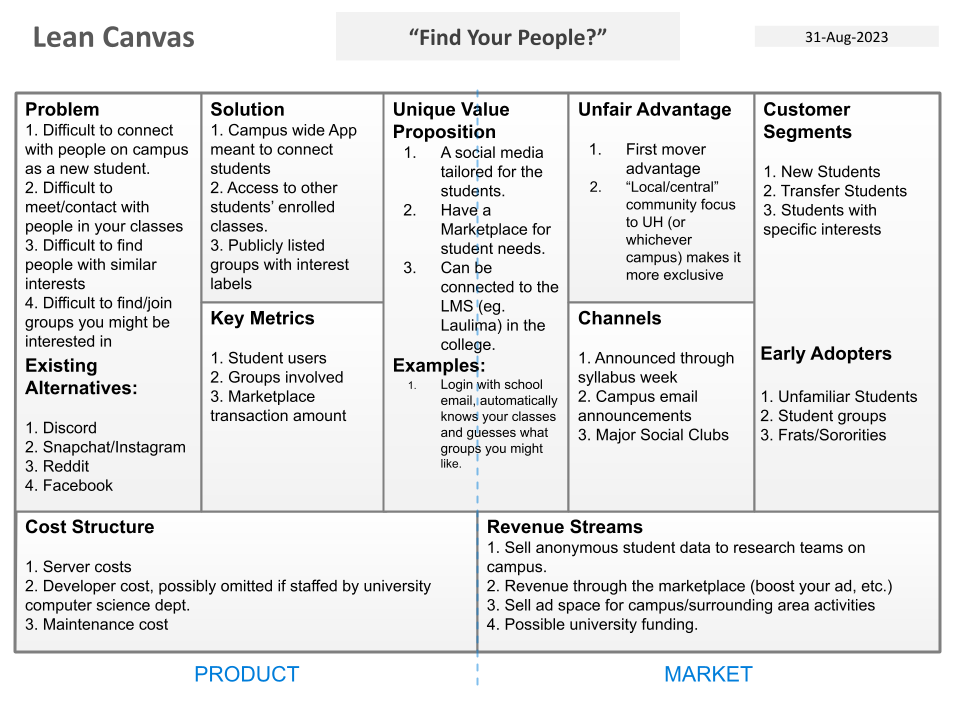
Wireframe:
Exercise Tamagotchi
Problem:
- Many people live sedentary lifestyles and lack motivation to exercise.
- Many people would like to raise pets but don’t have the time or money to do so.
Solution:
- Encourage people to get outside and exercise by gamifying movement and providing motivation to take care of their virtual pet.
- Spending time outside and exercising is positively correlated with increased mental and physical health.
Implementation concepts:
- Pet will get sick and die if you go long enough without exercising.
- GPS will track user activity to make sure they are doing the right exercise (or combination of exercises) for their pet.
- If you want to exercise through swimming, then your pet might be an aquatic animal (that requires you to swim to keep it alive). If you want to hike, then your pet might be a forest animal (that requires you to hike to keep it alive). If you want to both swim and hike, then your pet might be a forest river animal (that requires you to be swim and hike to keep it alive).
Why mobile:
- You can take your phone with you and it will use GPS location and activity monitoring (walking, running, driving, etc).
Lean Canvas business models:
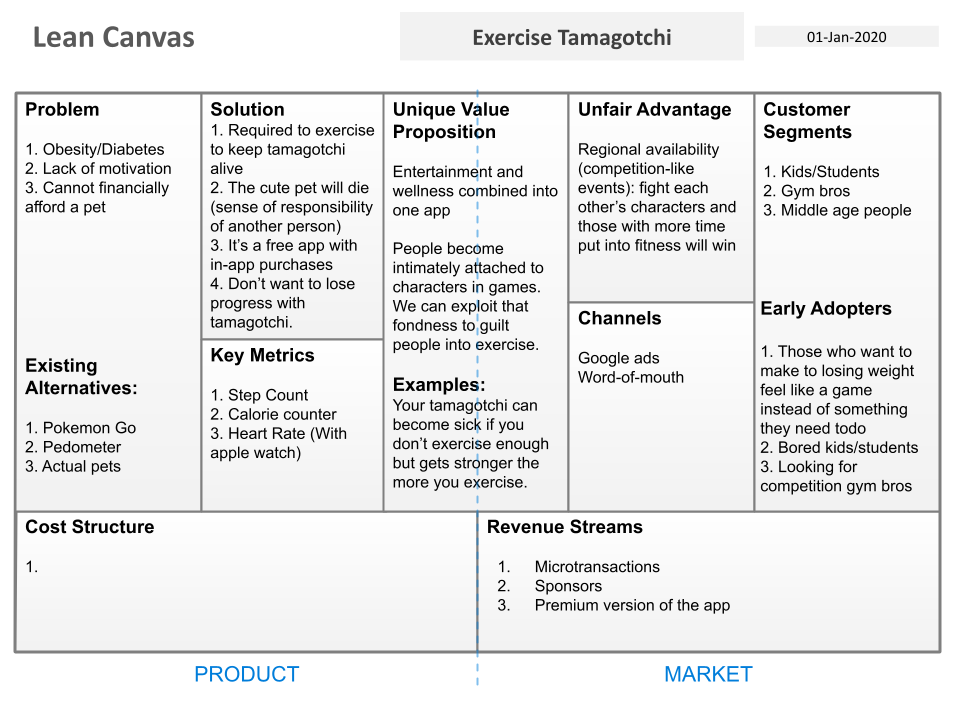
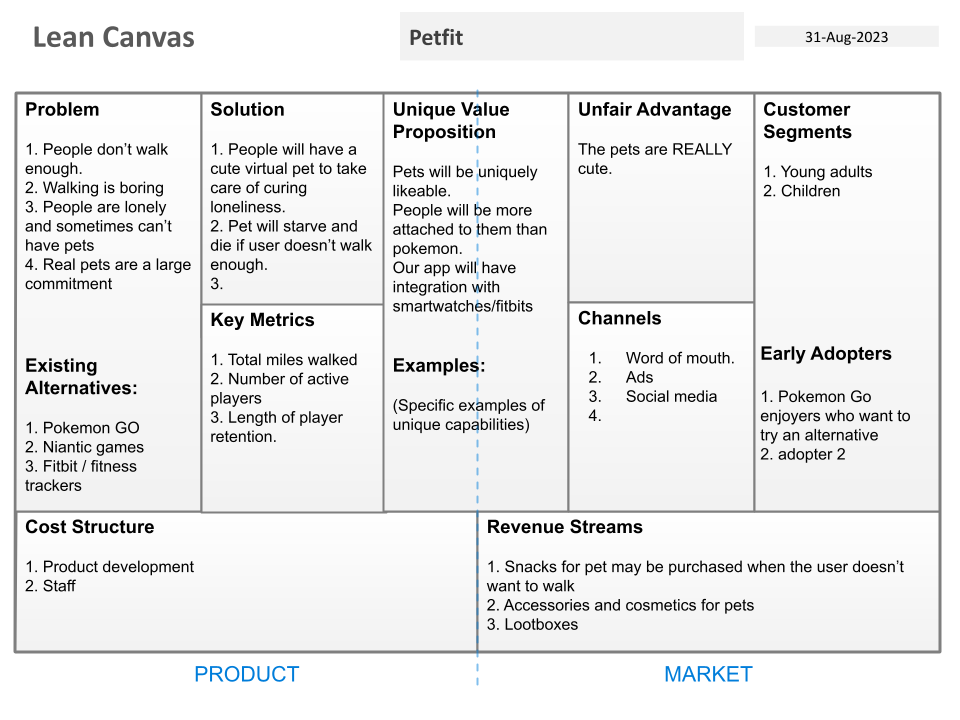
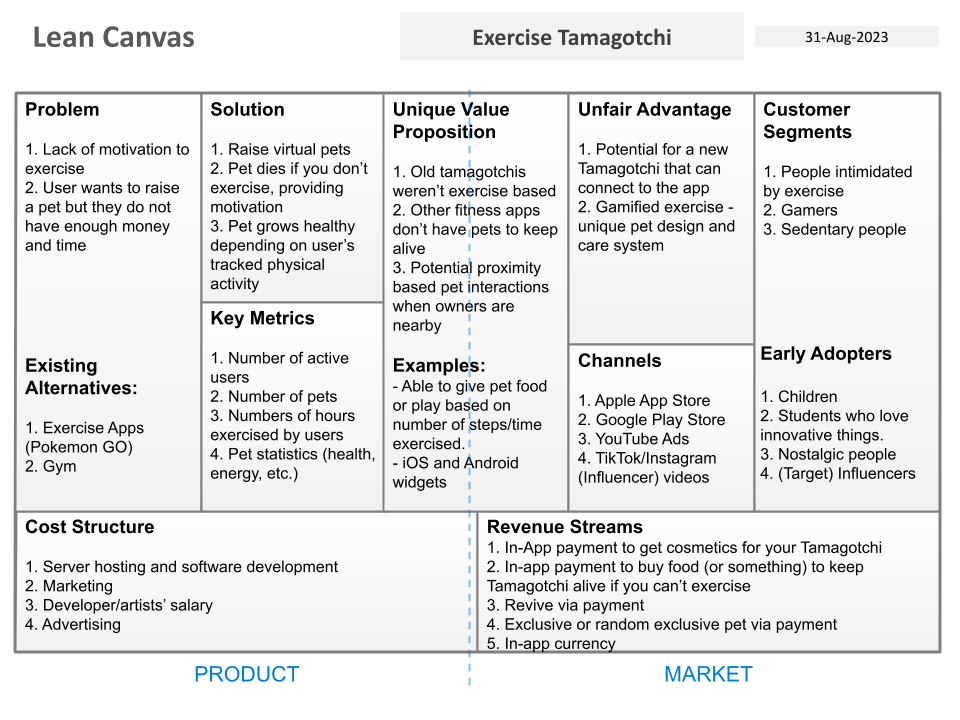
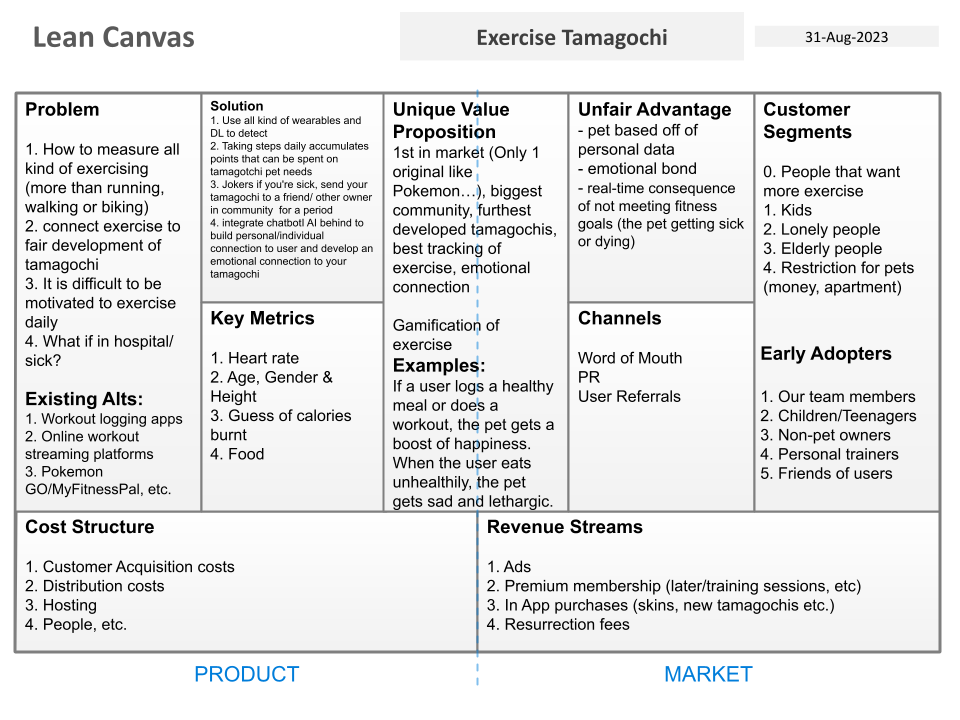
Wireframes:
- https://docs.google.com/presentation/d/1r-NZfMYEwRSddWeqd2oxBjPBvoykO-lNYWD2cQuSQJ8/edit#slide=id.g260a46b51d6_0_0
- https://docs.google.com/presentation/d/1XiToDWkU0Lt3IsqyHuQzTgBCDa7eb2AB70vGdzOCJP8/edit#slide=id.g260a46b51d6_0_0
- https://docs.google.com/presentation/d/1BZw5b4Fy2gnVoIGuWyZVwN9aKuwnhz1jClLB7PKgF4U/edit#slide=id.g260a46b51d6_0_0
- https://docs.google.com/presentation/d/1zEDLTMvurZIyGD6vTSZy0L_vndZYuBQjbTBdG7kQIkM/edit#slide=id.g260a46b51d6_0_0
Local Fashion Exchange
Problem:
- Fashion is big business, and so advertising and influencers are deployed to create the urge to spend money to look good.
- Production of new clothing both requires natural resources and can result in human exploitation (“sweat shops”).
Solution:
- Fashion is also about presenting yourself in an artistic, authentic manner, and finding clothing options that reflect how you feel about yourself or the world on any given day. This doesn’t require new clothes. It doesn’t even necessarily require buying clothes.
- The goal of this app is to create a mechanism for people (and organizations like Salvation Army, Goodwill, vibuntage stores) to buy, sell, give away, or trade clothing.
- It could be like “Stitch Fix”, where a person enters information about their size and style preferences and an underlying AI classifies and matches them with clothing that should suit them.
- This app can reduce the amount of clothing that enters the waste stream, and also decrease the amount of clothing that is manufactured, which preserves natural resources.
Why mobile:
- The app will encourage exchange of clothing without consumption of resources (i.e. shipping). A mobile app would enable users to meet up with each other via walking or bicycling.
Lean Canvas business model:

Wireframe:
- https://docs.google.com/presentation/d/1pJ7iyqt2Hi3TuavPEJJdC2viMWd7gR9Bhr_rO9FDYAo/edit#slide=id.g260a46b51d6_0_0
- https://docs.google.com/presentation/d/1FzeEo5bhTRUITLUJFXqBlUqLQfAFQAcjN-Q9-i-meVw/edit#slide=id.g260a46b51d6_0_0
Lean mean pet feeding machine
Problem:
- About 60% of domestic cats and dogs are obese. This is ridiculous!
Solution:
- This app helps pet owners to regulate food portion and recommend foods based on their pets’ age and breed.
- The app can allow the owner to take a picture and/or input weight information about their pet. The app can track weight over time and adjust portions appropriately.
- This app improves the health of pets, resulting in better mental and physical health for human and non-human animals. It also reduces the need to produce expensive therapy treatments for pets.
Why mobile:
- Pet owners will be more likely to use this if they can take out their phone in the kitchen, and not have to boot up their laptop.
- It is easier to use a camera on a phone to take a picture of your pet.
Lean Canvas business models:
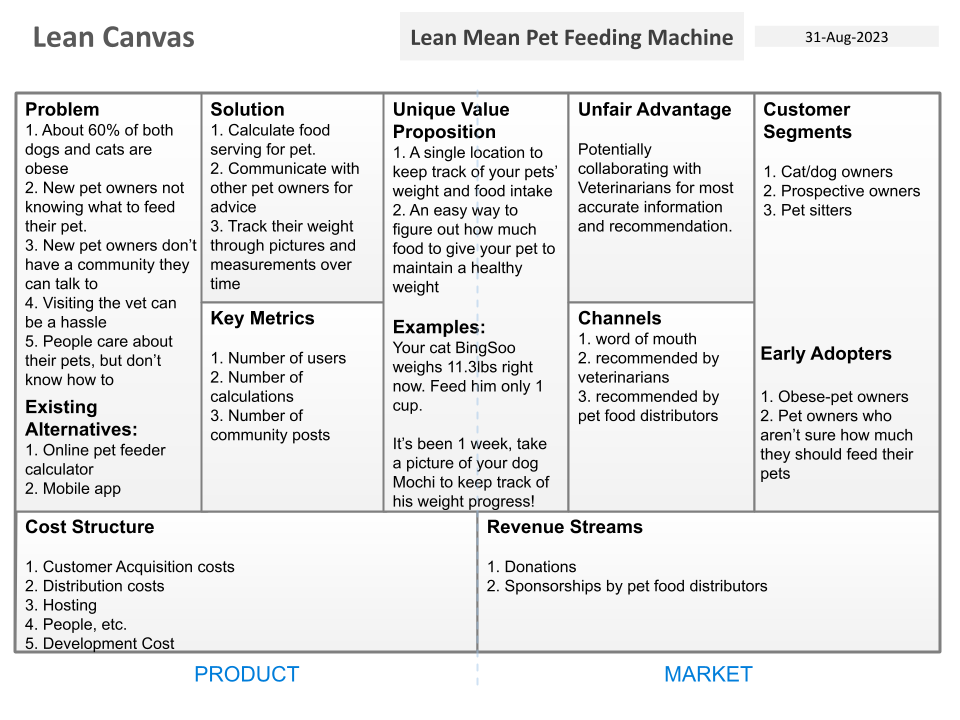
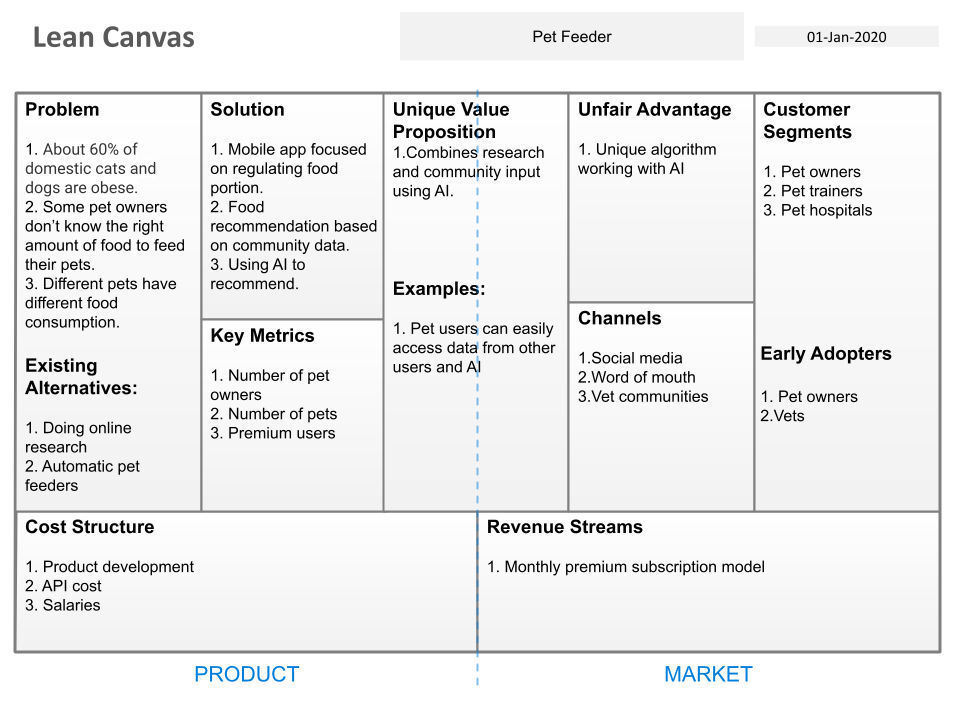
Wireframe:
- https://docs.google.com/presentation/d/15vRFCQiKt2SkM9KjHNOMmFG5JAampQlJ9-hRoIE5XTI/edit#slide=id.g260a46b51d6_0_0
- https://docs.google.com/presentation/d/1M9Qx0DKIvlXEb53jeXC7zftrkrUWGVN3SscmGKxtey0/edit#slide=id.g260a46b51d6_0_0
Invasive species finder
Problem:
- Hawaiian ecosystems are under high levels of threat from numerous invasive species.
Solution:
- The power of crowdsourcing can be harnessed to monitor the spread of invasive species by documenting their locations with geotagged photos. These photos can be used to pinpoint the location of the species and contain their spread.
- Users who are unsure whether or not it’s an invasive species can take a picture and share it in a group to confirm with others.
- They can share to find effective control methods and determine if there is a government program for species control.
- This can help the government set up volunteer programs or organizations to clean up the invasive species.
Why mobile:
- Laptops aren’t good for taking pictures on a long hike.
Lean Canvas business model:
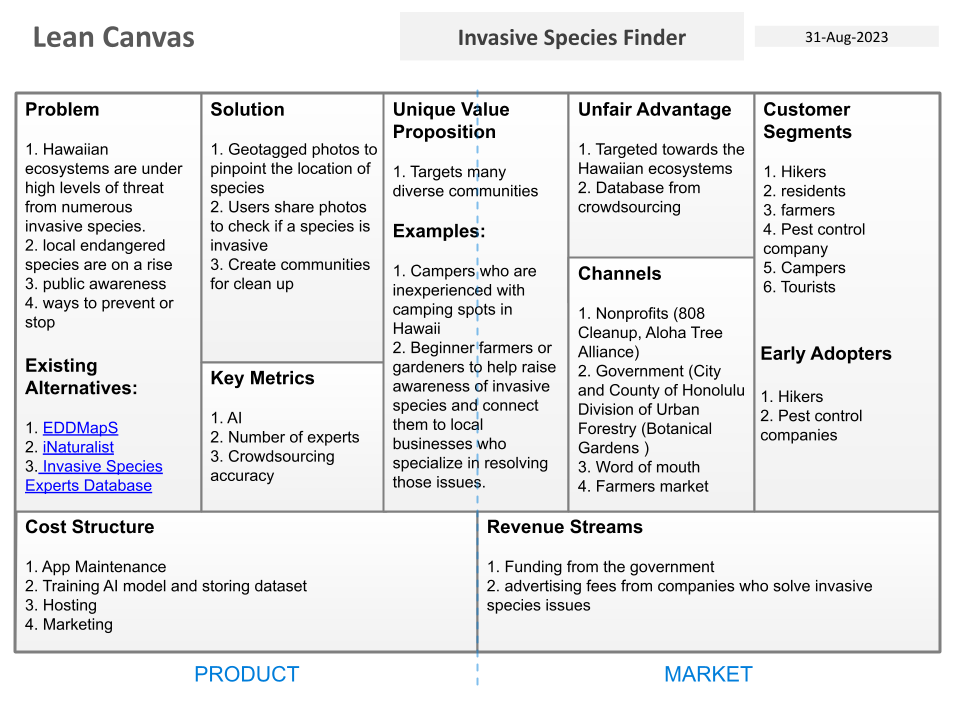
Wireframe:
FreeWork: Digital work from everywhere
Problem:
- Digital Work only in office and artificial light sucks hard sometimes. (I prefer to work at the beach, in a park, on a rooftop terrace/ mountain or wherever else than my little box or the library).
- It is hard to meet new people/ friends as adult other than colleagues from work.
- It is difficult to explore nature and work at the same time.
- When you work indoors, you do not reap the health benefits of the outdoors (fresh air, sunshine, natural lighting, etc.)
Solution:
- The FreeWork App knows your personal schedule, location & preferences for work (ergonomic / shadowed seating, electricity, close to coffee/ food/ WIFI, toilet etc.)
- Based on the weather forecast and your preferences, FreeWork suggests outdoor working locations. It also shows already occupied spots and proposes multiple options (also some new and random).
- You can use FreeWork to book non-traditional working spaces (i.e. people who rent their beautiful yard/property/roof, WIFI, electricity, seating, etc.) FreeWork is like AirBnB for co-working.
- FreeWork provides “hubs” to enable CoWorking Outdoors. This enables you to meet new people/ friends in other areas of work.
- FreeWork creates a community of like-minded people, which can foster new ideas and collaborations.
- FreeWork can reduce the need to create office space, conserving natural resources. It can also increase mental and physical health for participants.
Why mobile:
- Phone as organizer always at hand
- Enables GPS for location and booking.
- Easy communication (speech-to-text, text-to-speech)
- Easy payment by connection to ApplePay/ GooglePay/ Venmo etc.,
- Possibility to make own mobile hotspot for WIFI.
Lean Canvas business model:
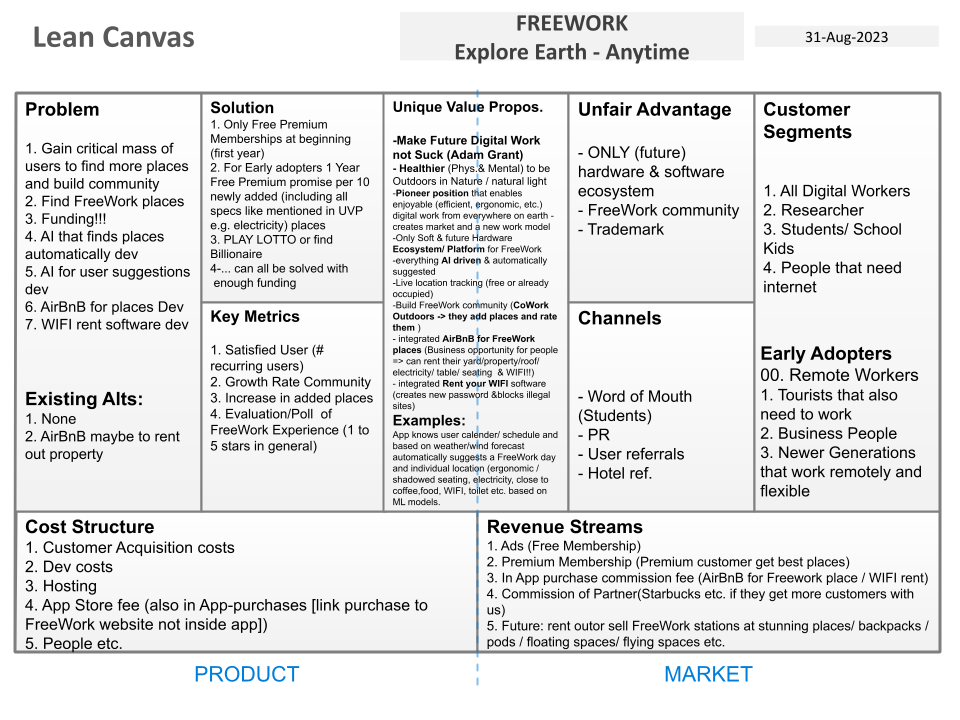
NutriSnap
Problem:
- Recent years have seen a surge in deaths caused by lifestyle diseases such as diabetes and cardiovascular disease among global populations. As a result, individuals and healthcare providers are interested in tracking dietary patterns to assist in making informed choices. There has been an increased demand for tools that facilitate easy and accurate food tracking, but conventional calorie counting applications are inconvenient and may cause individuals to focus on caloric goals over nutritional quality.
Solution:
- Several studies have highlighted the potential of AI in transforming healthcare and wellbeing. In the realm of food logging, AI can automate the process, making it quicker and more accurate. NutriSnap is a mobile food journaling app that can recognize the foods and portion sizes you eat from a photograph. Instead of giving you calorie counts, NutriSnap will track your dietary quality and encourage you to reduce your intake of processed foods over time.
Why mobile:
- A mobile app is an ideal solution for a photo-based food journal. Most individuals carry their phone with them everywhere, so logging a meal is as convenient as pointing your camera and snapping a photo.
Lean Canvas business model:

Wireframe:
Localizing the College Student Palette
Problem:
- Food insecurity is a huge problem in the face of climate change. Addressing food insecurity, particularly in Hawaii, means shifting diets toward the incorporation of local foods. College students, whose food preferences are still in flux and who are just starting to cook for themselves for the first time, represent a particularly valuable demographic to target. If we can get college students to shift their diet toward local foods, that can have very long term effects. College students also represent a demographic that should be easier to impact than others.
- Our app will be focused on college students and will help them to understand the value of eating local foods and provide them with ways to purchase and prepare them.
- It can also create a “community of practice” around preparation and eating of local foods.
Solution:
- An app that is oriented toward college students that enables them to enter their food preferences and provides them with a way to create meals that incorporate local foods. Support for this process includes:
- Adaption of recipes to include locally grown foods, and, where possible indigenous foods (ulu, taro, limu, etc.) which are better adapted to the local climate and growing conditions.
- Support for “supply chain” issues: enabling students to actually get access to local foods.
- Use of recipes that are suited to the economics, tastes, and culinary capabilities of college students.
- Support for creation of “cooking collectives”: students who want to band together to make meals using local foods.
Why mobile:
- Since this process involves a lot of “meeting up” (i.e. meeting up with others to cook, meeting up with suppliers to get local foods), a mobile phone is the most effective mechanism.
- There is no need to display a recipe on a laptop; a mobile phone is just fine.
Dish Data
Problem:
- Food resiliency in the face of climate change requires people to adjust their eating preferences to eat more foods that are grown locally, and more local (i.e. indigenous) foods (such as, in Hawaii, taro and ulu). Food resiliency also involves eating more vegetarian and/or vegan and/or less processed dishes.
- Not many restaurants serve “food resilient dishes”, as there is not much of a market for them. Conversely, people who want to eat food resilient dishes have a difficult time finding restaurants to serve them. This creates a catch-22 situation.
- It is difficult for people who have these kind of preferences to find each other and share experiences.
- Restaurant rating apps such as Yelp do not normally provide “dish-level” data and do not provide facilities to filter entrees by ingredients or preparation.
- A related problem is “plate waste”: food left on a plate that must be thrown away.
Solution:
- Dish Data will provide a system for restaurant visitors to provide data about individual dishes and “tag” them in various ways. These tags can help identify and market food resilient dishes to the community, increasing demand for them. This can lead to more income for restaurants currently serving food resilient dishes, and more restaurants willing to try serving food resilient dishes since there is a marketing vehicle for them.
- By providing improved information about dishes before ordering, we hope this app will reduce plate waste.
Why mobile:
- It is useful to snap a picture of the dish during evaluation
- It is not common to have a laptop with you when you are eating at a restaurant.
Lean Canvas business model:

Pocket Dad
Problem:
- Many young people have to navigate early adulthood without sufficient guidance for facing practical challenges.
- These challenges may include keeping up with regular maintenance tasks associated with their house or car, remembering to pay their taxes, or simply tying a tie.
Solution:
- PocketDad is a personal digital assistant that will remind the user of important tasks, such as filing taxes, cleaning the air filters in their home, or checking the tread of their tires before the winter season.
- It will also provide instructions on how to carry out these tasks as well as recommendations for specific maintenance services.
- PocketDad will also be able to offer general advice directed toward the specific user based on its knowledge of them.
Why mobile:
- Mobile devices are ideal for reminding users of important tasks due to their frequency of use.
- Similar to how one might message a friend or a mentor, the user can consult PocketDad at any time in which they may need guidance.
Lean Canvas business model:
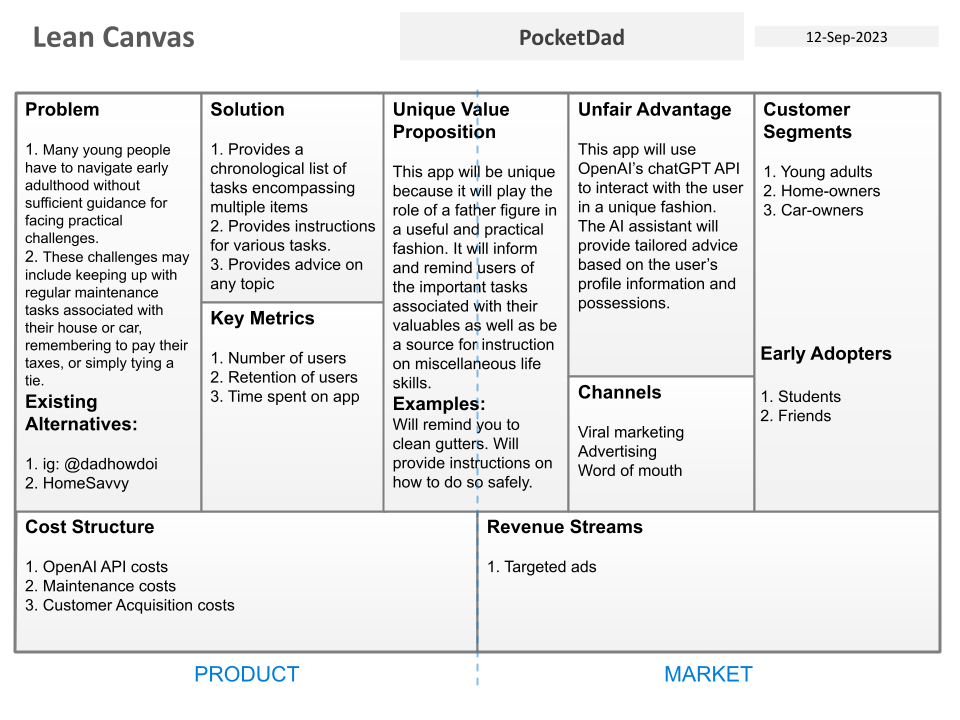
Learn to code through game play
This project is PENDING and not yet approved. This is because no clear description has yet been provided for how programming concepts can actually be taught on a mobile phone. It is not appropriate to use traditional programming textual languages on a phone, since they require a lot of typing and that is problematic on a phone. So, for this project to be accepted, a clear concept for how programming concepts can be taught using a non-textual interface must be provided.
Problem:
- Learning a programming language is unwelcoming, challenging, and can be uninteresting.
- Coding requires a laptop and installation of special software.
- Some people who might otherwise enjoy coding get turned off by the high overhead to understanding enough to finish their first (interesting) program.
- Creating a way to learn programming concepts using only a mobile phone will open up the world of computational thinking to those who don’t have access to a laptop.
Solution:
- This app aims to gamify learning a programming language. Similar to other apps, like Duolingo, that gamify learning a new language, this app will provide an accessible and engaging way to learn how to code through games, challenges, etc.
- This app would provide an introduction to programming for those who do not have access to a laptop.
Why mobile:
- As a mobile app, the experience can be more casual by taking advantage of empty time in your day (commuting, waiting for a class to start, etc.)
- Mobile phones are cheaper than laptops, and many more people have them.
Lean Canvas business model:
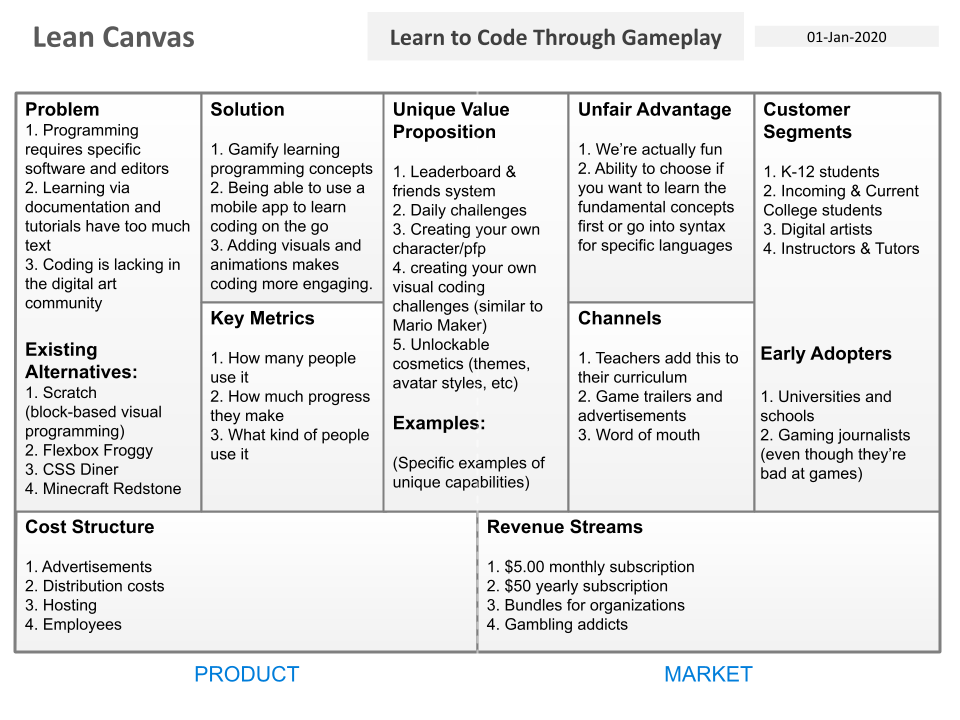
Wireframe: